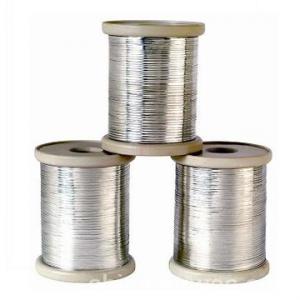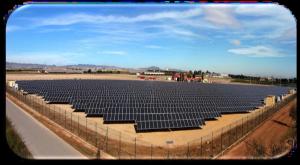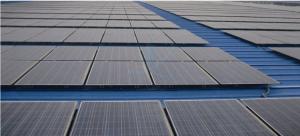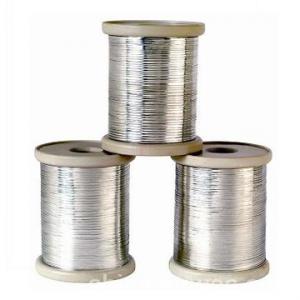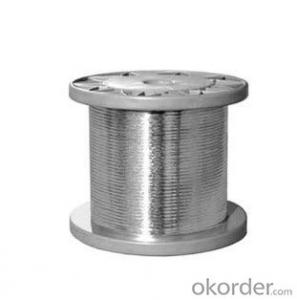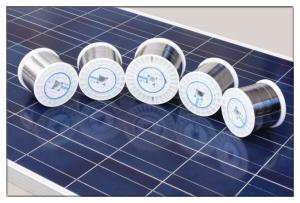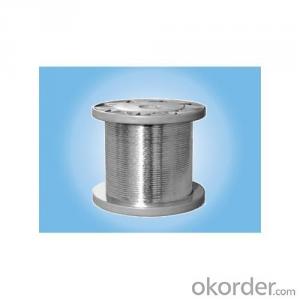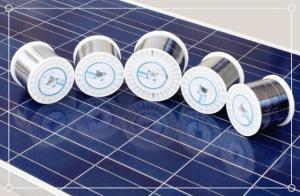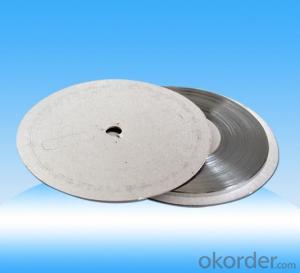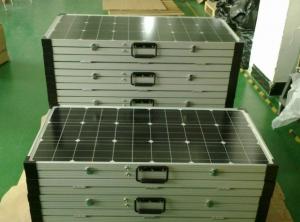Bus Ribbon-manual welding 0.35*6
- Loading Port:
- China Main Port
- Payment Terms:
- TT or LC
- Min Order Qty:
- -
- Supply Capability:
- -
OKorder Service Pledge
OKorder Financial Service
You Might Also Like
Structure
We produce custom engineered solar tabbing and bus wire helping to attain the highest efficiencies possible for each unique module design. Our Research and Development team can assist you with your needs evaluation and our world-wide manufacturing facilities are strategically located for large volume production.
Feature
The Flux should be compounded and processed in such a manner as to be uniform in quality and should be free from deleterious material and other details that will after life serviceability or appearance.
Cold Rolling Mills for manufacturing Photovoltaic (PV) Ribbon:
Cold Rolling Mills for manufacturing Photovoltaic Ribbon
This machine is for making Bare flat copper conductors which is using PV Ribbon Wire , Tinned plated flat copper conductors which is using FFC or materials and it was designed to make the best quality products with high productivity as well as easy to control.
Machine capacity
Tinned plated flat copper conductors which is using FFC
Images
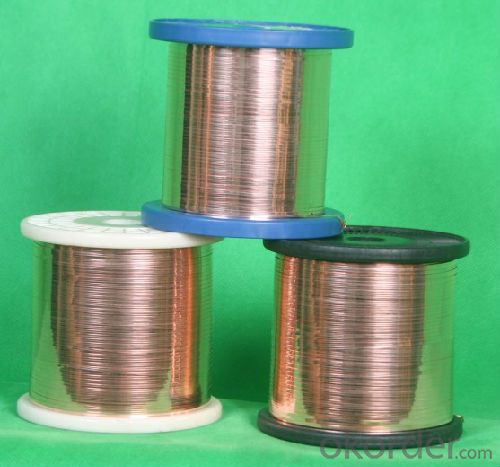
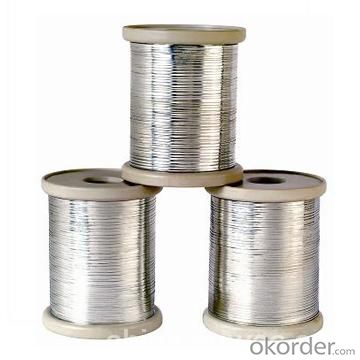
Specifications
Mechanical Property:
1,Elongation: E-Soft≥20% U-Soft≥15%
2,Tensile strength:≥170MPa
3,Side camber: L≤3mm/1000mm
4,Soldering tin melting point: 180−230°c
Electrical Resistivity of Copper:
TU1≤0.0618 Ω • m m2/m; T2≤0.01724 Ω•m m2/m
Core Copper of TU1 Off-Cu :
1,Copper Purity 9≥9.97%, Oxygen≤10ppm
2,Resistivity:ρ20≤0.017241Ω • m m2/m
Electrical Resistivity of Ribbon:
(2.1−2.5)X10-2 • mm2/m
Plated Thickness:
15-25um per side
FAQ
Q:How to guarantee the quality of the products?
A:We have established the international advanced quality management system,every link from raw material to final product we have strict quality test;We resolutely put an end to unqualified products flowing into the market. At the same time, we will provide necessary follow-up service assurance.
Q:Can we visit your factory?
A:Surely, I will arrange the trip basing on your business schedule.
Q:Which payment terms can you accept?
A:T/T,L/C,Moneygram,Paypal are available for us.
- Q: What is the maximum number of MPPT inputs in a solar inverter?
- The maximum number of MPPT inputs in a solar inverter can vary depending on the model and manufacturer. However, it is common to find solar inverters with a maximum of two or four MPPT inputs.
- Q: What are the financial benefits of installing a solar energy system?
- Installing a solar energy system offers several financial benefits, including reduced electricity bills as solar power generates free electricity from the sun. Additionally, solar panels can generate excess electricity that can be sold back to the grid, potentially earning homeowners a profit. Moreover, installing solar energy systems can provide tax incentives, such as federal tax credits, and in some cases, local rebates or grants. Over time, solar panels can increase the value of a property, making it a wise long-term investment.
- Q: What materials are solar panels made of?
- Solar panels are typically made of photovoltaic (PV) cells, which are primarily composed of silicon, along with other materials such as metal frames, glass, and encapsulation materials.
- Q: Can solar energy systems be used in powering outdoor signage or billboards?
- Yes, solar energy systems can be used to power outdoor signage or billboards. Solar panels can be installed on the structures and absorb sunlight to generate electricity, which can then be used to power the signage or billboards. This reduces the reliance on traditional energy sources and helps to make outdoor advertising more sustainable.
- Q: Can solar silicon wafers be used in floating solar power plants?
- Yes, solar silicon wafers can be used in floating solar power plants. These floating solar power plants are designed to harness solar energy by placing photovoltaic panels on floating platforms on water bodies such as lakes, reservoirs, or even the ocean. The solar silicon wafers serve as the main component of the photovoltaic panels, converting sunlight into electricity. Floating solar power plants offer numerous advantages, including increased efficiency due to the cooling effect of the water and the ability to utilize unused water surfaces, making solar silicon wafers a suitable choice for such installations.
- Q: Can a solar pump be used in areas with limited access for maintenance?
- Yes, a solar pump can be used in areas with limited access for maintenance. Solar pumps are designed to be low maintenance, durable, and reliable. They do not require fuel or electricity, and their components are built to withstand harsh weather conditions. Additionally, they have fewer moving parts, reducing the need for regular servicing. Therefore, solar pumps are well-suited for remote locations with limited accessibility for maintenance.
- Q: quot;Does it take more energy to produce a solar panel than what the same solar panel can generate in its useful lifetime?quot;
- Thor is right and wrong. Solar panel will produce more than they take to make. My solar panels only have a 0 year estimated useful life. They may actually last longer, but with time they lose efficiency. Here in Phoenix where the sun shines all the time, a decent solar system you purchase and pay to have installed will pay back the original investment in 5-20 years. If you are a handyman and can install it yourself it will pay back sooner. Solar is a great system for reducing CO2 pollution, but until grid power rates increase a lot, it is still not very cost effective in most areas. It is also a myth that anyone can just install a solar system and get off grid power. Most people could not afford it, and most people would not like not having heat or air. Any system that normal people could afford could not supply anywhere near enough power for heating or air conditioning.
- Q: What is the reason for the original or the original silicon?
- Sand cutting is the case, it is silicon cutting related issues,
- Q: How do solar lights handle electromagnetic fields?
- Solar lights do not have any specific mechanisms to handle electromagnetic fields. However, they are generally designed to be resistant to electromagnetic interference and can operate in the presence of electromagnetic fields without significant issues. The photovoltaic cells in solar lights convert sunlight into electricity, and electromagnetic fields are not known to interfere with this process. Additionally, solar lights usually have simple electronic circuits that are not highly sensitive to electromagnetic interference. However, it is important to note that extremely powerful electromagnetic fields, such as those generated by high-voltage power lines or strong radio transmitters, could potentially cause some interference or reduce the efficiency of the solar lights. In such cases, it may be necessary to place the lights at a distance from the source of the electromagnetic field to ensure optimal performance.
- Q: Can a solar pump be used in areas with high levels of pollution?
- Yes, a solar pump can be used in areas with high levels of pollution. Solar pumps operate using solar energy, which is a clean and renewable source of power. They do not emit any pollutants themselves, so they can still function effectively in polluted environments. However, it is important to ensure regular maintenance and cleaning of the solar panels to prevent dust and pollution buildup, which may affect the pump's efficiency.
Send your message to us
Bus Ribbon-manual welding 0.35*6
- Loading Port:
- China Main Port
- Payment Terms:
- TT or LC
- Min Order Qty:
- -
- Supply Capability:
- -
OKorder Service Pledge
OKorder Financial Service
Similar products
Hot products
Hot Searches
